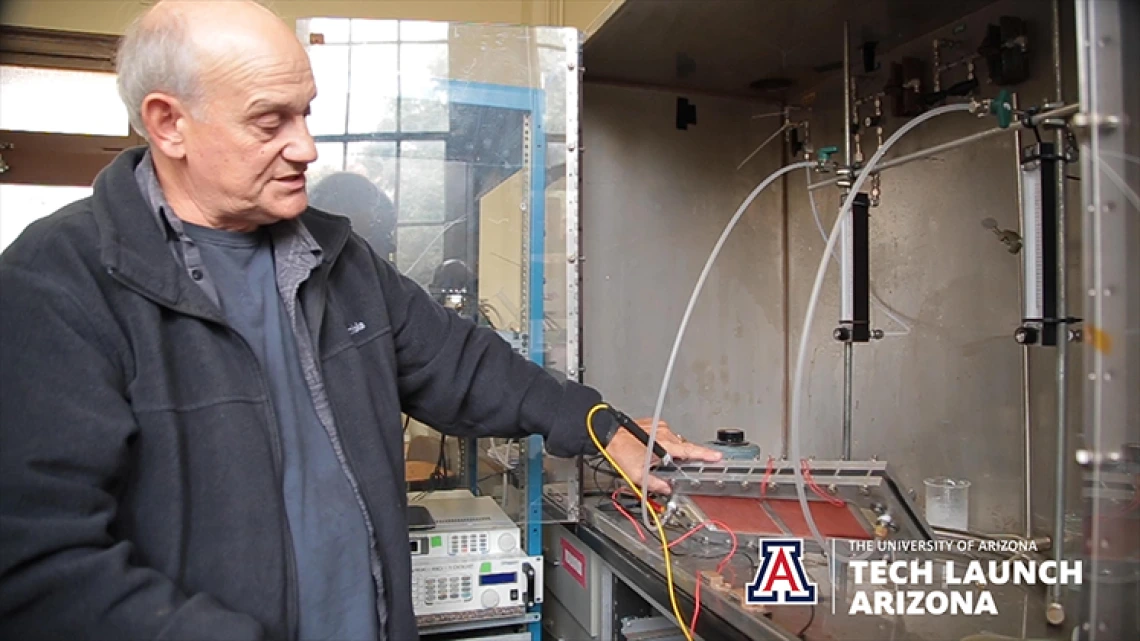Tech Blog: College of Engineering Professor Develops Improved Fuel Cell

| Watch the new episode of Invented Arizona, where we speak with Dominic Gervaisio, PhD, about a more efficient fuel cell developed in his lab.
|
How are inventors at the University of Arizona helping push the envelop of current fuel cell technologies? We vistied Don Gervasio, PhD, Associate Professor in the Department of Chemical and Environmental Engineering, who took us on a tour us through one of the latest inventions coming out of his lab: a more efficient high temperature fuel cell.
What is your invention?
This is a high temperature polymer electrolyte fuel cell. All a fuel cell does, is it takes oxygen from air and hydrogen that you make by reforming oil and you convert them to electricity directly. In order to make electricity, you have got to convert a hydrogen atom into a proton at one electrode, and then oxygen is made into water by taking electrons in the external circuit, injecting the oxygen and then protons come through the membrane. This new fuel cell stack design uses new composite membrane electrode assemblies and new liquid cooled metallic bipolar plates to replace the conventional graphite plates and the cooling plates. The design allows it to operate at high temperatures with no need for water, which significantly reduces size and weight. It’s a very efficient way to convert chemicals to electricity.
What problem does it solve?
Fuel cells are the next logical step beyond internal combustion engines and batteries. They can be used as automotive power plants and aircraft auxiliary power units. Instead of your internal combustion or turbine engine, you can have a fuel cell as the primary power generator. There is also interest for remote places and places that have bad weather. Every time there is an earthquake or tsunami in Japan, their infrastructure is knocked out because once you break an electric wire, you can’t deliver power down the line. Natural gas distribution lines are in the ground, so they are less disturbed by these kinds of events, and these fuel cells would function using natural gas.
How is your invention different from preexisting ones?
This fuel cell transmits the proton with no need for water; it doesn’t have to be hydrated, it improves the efficiency, and it operates at high temperature, which reduces the size and weight – a very important feature, especially for aircraft. We’re trying to make something that is stable so that it has the lifetime of an automobile engine, and that can be used as a generator for auxiliary power backup.
Who would be the top beneficiaries of a technology like this?
We think the people most interested in this kind of fuel cell would be automotive and airline companies, the military, geographies that regularly experience bad weather, and wherever there is a remote need for power.
How will this invention change current standard practices?
What’s really great about this is that there are a lot of advances over current fuel cell technology. We have improved the overall efficiency by operating at higher temperatures, which is allowed by our new membrane and metal bipolar plate technology. This, with 3D printing technology, we can really lower the cost of manufacturing and operating a fuel cell.
Who funded the research?
We were funded by the United States Department of Energy and the US Army. The research on the membrane development was funded by the Army Research Office. We also had support on metal bipolar plates in conjunction with Oak Ridge National Lab.
Learn more about this technology:
UA18-214 High Temperature Fuel Cell System
Learn more about other related technologies:
UA15-110 Hybrid Microbial-Enzymatic Fuel Cell
UA18-251 Catalyst for Auto-Thermal Reforming of Hydrocarbon Fuels Making Hydrogen

